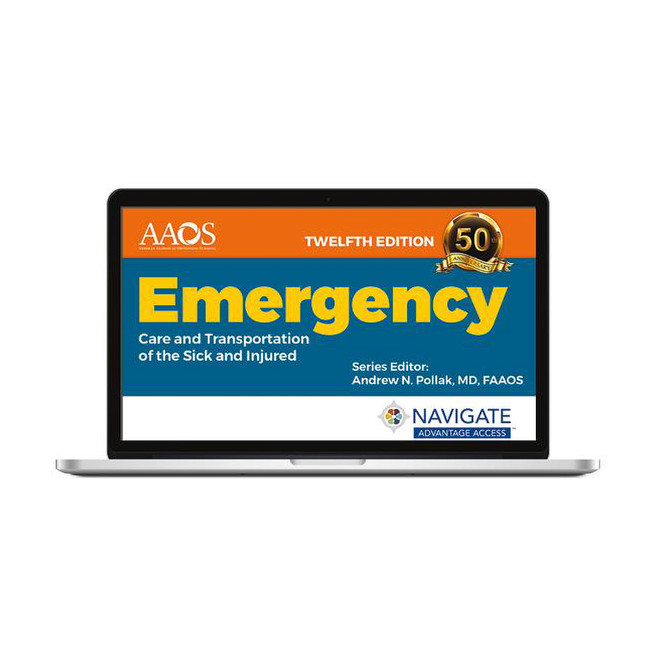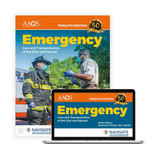Navigate 2 Advantage Access Code for Emergency Care and Transportation of the Sick and Injured, 12th Edition
Since 1971, Emergency Care and Transportation of the Sick and Injured has advanced how EMS education is delivered to help train exceptional EMS professionals around the globe. Fifty years later, the Twelfth Edition is now the most comprehensive, innovative EMT educational solution ever developed. Concepts of teamwork, communication, and empathy are woven throughout the chapters, challenging students to become more compassionate, conscientious health care professionals as well as skilled clinicians.
Current, State-of-the-Art Content
The Twelfth Edition delivers the latest medical evidence and alignment to current standards, along with a revised layout to improve readability.
- Comprehensive coverage of the National EMS Education Standards and the 2020 American Heart Association (AHA) Guidelines for Cardiopulmonary Resuscitation and Emergency Cardiovascular Care (ECC).
- Updated coverage of PPE and CDC guidelines for safe patient care during COVID-19 pandemic.
A Focus on Career Readiness and Employability
For those who care about more than just pass rates, the Twelfth Edition is devoted to addressing the most common job readiness issues reported by employers.
- Greater emphasis on empathy, teamwork, interpersonal skills, and problem solving to ensure students are well prepared as they transition into the field.
- A new “Street Smarts” feature that helps bridge the gap between the classroom and field environment by addressing nontechnical skills that improve patient and co-worker interactions.
- Enhanced content on provider mental health, wellness, and safety.
Table of Contents
- Section 1 Preparatory
- Chapter 1 EMS Systems
- Chapter 2 Workforce Safety and Wellness
- Chapter 3 Medical, Legal, and Ethical Issues
- Chapter 4 Communication and Documentation
- Chapter 5 Medical Terminology
- Chapter 6 The Human Body
- Chapter 7 Life Span Development
- Chapter 8 Lifting and Moving Patients
- Chapter 9 The Team Approach to Health Care
- Section 2 Patient Assessment
- Chapter 10 Patient Assessment
- Section 3 Airway
- Chapter 11 Airway Management
- Section 4 Pharmacology
- Chapter 12 Principles of Pharmacology
- Section 5 Shock and Resuscitation
- Chapter 13 Shock
- Chapter 14 BLS Resuscitation
- Section 6 Medical
- Chapter 15 Medical Overview
- Chapter 16 Respiratory Emergencies
- Chapter 17 Cardiovascular Emergencies
- Chapter 18 Neurologic Emergencies
- Chapter 19 Gastrointestinal and Urologic Emergencies
- Chapter 20 Endocrine and Hematologic Emergencies
- Chapter 21 Allergy and Anaphylaxis
- Chapter 22 Toxicology
- Chapter 23 Behavioral Health Emergencies
- Chapter 24 Gynecologic Emergencies
- Section 7 Trauma
- Chapter 25 Trauma Overview
- Chapter 26 Bleeding
- Chapter 27 Soft-Tissue Injuries
- Chapter 28 Face and Neck Injuries
- Chapter 29 Head and Spine Injuries
- Chapter 30 Chest Injuries
- Chapter 31 Abdominal and Genitourinary Injuries
- Chapter 32 Orthopaedic Injuries
- Chapter 33 Environmental Health Emergencies
- Section 8 Special Patient Populations
- Chapter 34 Obstetrics and Neonatal Care
- Chapter 35 Pediatric Emergencies
- Chapter 36 Geriatric Emergencies
- Chapter 37 Patients with Special Challenges
- Section 9 EMS Operations
- Chapter 38 Transport Operations
- Chapter 39 Vehicle Extrication and Special Rescue
- Chapter 40 Incident Management
- Chapter 41 Terrorism Response and Disaster Management
** The Access Code is contained on a physical card which will be shipped **
This book is published by the Public Safety Group under Jones & Bartlett.









